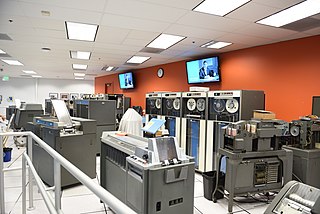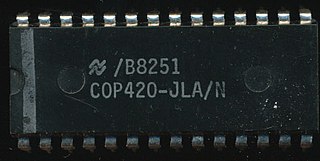Related Research Articles

An electronic calculator is typically a portable electronic device used to perform calculations, ranging from basic arithmetic to complex mathematics.

The Intel 8080 ("eighty-eighty") is the second 8-bit microprocessor designed and manufactured by Intel. It first appeared in April 1974 and is an extended and enhanced variant of the earlier 8008 design, although without binary compatibility. Although earlier microprocessors were commonly used in mass-produced devices such as calculators, cash registers, computer terminals, industrial robots, and other applications, the 8080 saw greater success in a wider set of applications, and is largely credited with starting the microcomputer industry.

Reverse Polish notation (RPN), also known as reverse Łukasiewicz notation, Polish postfix notation or simply postfix notation, is a mathematical notation in which operators follow their operands, in contrast to prefix or Polish notation (PN), in which operators precede their operands. The notation does not need any parentheses for as long as each operator has a fixed number of operands.
In computer science, an instruction set architecture (ISA) is an abstract model that generally defines how software controls the CPU in a computer or a family of computers. A device or program that executes instructions described by that ISA, such as a central processing unit (CPU), is called an implementation of that ISA.
Very long instruction word (VLIW) refers to instruction set architectures that are designed to exploit instruction-level parallelism (ILP). A VLIW processor allows programs to explicitly specify instructions to execute in parallel, whereas conventional central processing units (CPUs) mostly allow programs to specify instructions to execute in sequence only. VLIW is intended to allow higher performance without the complexity inherent in some other designs.

The Intel 8008 is an early 8-bit microprocessor capable of addressing 16 KB of memory, introduced in April 1972. The 8008 architecture was designed by Computer Terminal Corporation (CTC) and was implemented and manufactured by Intel. While the 8008 was originally designed for use in CTC's Datapoint 2200 programmable terminal, an agreement between CTC and Intel permitted Intel to market the chip to other customers after Seiko expressed an interest in using it for a calculator.

The IBM 1401 is a variable-wordlength decimal computer that was announced by IBM on October 5, 1959. The first member of the highly successful IBM 1400 series, it was aimed at replacing unit record equipment for processing data stored on punched cards and at providing peripheral services for larger computers. The 1401 is considered by IBM to be the Ford Model-T of the computer industry due to its mass appeal. Over 12,000 units were produced and many were leased or resold after they were replaced with newer technology. The 1401 was withdrawn on February 8, 1971.

The Intel 4004 is a 4-bit central processing unit (CPU) released by Intel Corporation in 1971. Sold for US$60, it was the first commercially produced microprocessor, and the first in a long line of Intel CPUs.

The history of computing hardware starting at 1960 is marked by the conversion from vacuum tube to solid-state devices such as transistors and then integrated circuit (IC) chips. Around 1953 to 1959, discrete transistors started being considered sufficiently reliable and economical that they made further vacuum tube computers uncompetitive. Metal–oxide–semiconductor (MOS) large-scale integration (LSI) technology subsequently led to the development of semiconductor memory in the mid-to-late 1960s and then the microprocessor in the early 1970s. This led to primary computer memory moving away from magnetic-core memory devices to solid-state static and dynamic semiconductor memory, which greatly reduced the cost, size, and power consumption of computers. These advances led to the miniaturized personal computer (PC) in the 1970s, starting with home computers and desktop computers, followed by laptops and then mobile computers over the next several decades.
In computer science, computer engineering and programming language implementations, a stack machine is a computer processor or a virtual machine in which the primary interaction is moving short-lived temporary values to and from a push down stack. In the case of a hardware processor, a hardware stack is used. The use of a stack significantly reduces the required number of processor registers. Stack machines extend push-down automata with additional load/store operations or multiple stacks and hence are Turing-complete.
A branch, jump or transfer is an instruction in a computer program that can cause a computer to begin executing a different instruction sequence and thus deviate from its default behavior of executing instructions in order. Branch may also refer to the act of switching execution to a different instruction sequence as a result of executing a branch instruction. Branch instructions are used to implement control flow in program loops and conditionals.

In electronics, computer science and computer engineering, microarchitecture, also called computer organization and sometimes abbreviated as μarch or uarch, is the way a given instruction set architecture (ISA) is implemented in a particular processor. A given ISA may be implemented with different microarchitectures; implementations may vary due to different goals of a given design or due to shifts in technology.

The Digi-Comp I is a functioning, mechanical digital computer sold in kit form. It was originally manufactured from polystyrene parts by E.S.R., Inc. starting in 1963 and sold as an educational toy for US$4.99.
Minimal instruction set computer (MISC) is a central processing unit (CPU) architecture, usually in the form of a microprocessor, with a very small number of basic operations and corresponding opcodes, together forming an instruction set. Such sets are commonly stack-based rather than register-based to reduce the size of operand specifiers.
Monroe Systems for Business is a provider of electric calculators, printers, and office accessories such as paper shredders to business clients. Originally known as the Monroe Calculating Machine Company, it was founded in 1912 by Jay Randolph Monroe as a maker of adding machines and calculators based on a machine designed by Frank Stephen Baldwin. It was later known as Monroe THE Calculator Company, and Monroe Division of Litton Industries.

The history of general-purpose CPUs is a continuation of the earlier history of computing hardware.

The HP 35s (F2215A) is a Hewlett-Packard non-graphing programmable scientific calculator. Although it is a successor to the HP 33s, it was introduced to commemorate the 35th anniversary of the HP-35, Hewlett-Packard's first pocket calculator. HP also released a limited production anniversary edition with shiny black overlay and engraving "Celebrating 35 years".

The TMS1000 is a family of microcontrollers introduced by Texas Instruments in 1974. It combines a 4-bit central processor unit, read-only memory (ROM), random access memory (RAM), and input/output (I/O) lines as a complete "computer on a chip". It was intended for embedded systems in automobiles, appliances, games, and measurement instruments. It was the first high-volume, general-purpose commercial microcontroller. In 1974, chips in this family could be purchased in volume for around $2 each. By 1979 about 26 million parts in this family were sold every year.

The COP400 or COP II is a 4-bit microcontroller family introduced in 1977 by National Semiconductor as a follow-on product to their original PMOS COP microcontroller. COP400 family members are complete microcomputers containing internal timing, logic, ROM, RAM, and I/O necessary to implement dedicated controllers. Some COP400 devices were second-sourced by Western Digital as the WD4200 family. In the Soviet Union several COP400 microcontrollers were manufactured as the 1820 series.

Atari Calculator is a proprietary software program developed by Atari, Inc. for Atari 8-bit computers and publoished in 1979. It incorporates the functionality of a scientific calculator into a software calculator. It was written in assembly language by American programmer and game designer Carol Shaw. The program supports multiple modes, including enabling it to be used as a programmable calculator with a then-popular reverse Polish notation (RPN) input method.